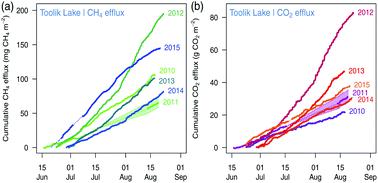当前位置:
X-MOL 学术
›
Environ. Sci.: Processes Impacts
›
论文详情
Our official English website, www.x-mol.net, welcomes your
feedback! (Note: you will need to create a separate account there.)
Interannual, summer, and diel variability of CH4 and CO2 effluxes from Toolik Lake, Alaska, during the ice-free periods 2010–2015
Environmental Science: Processes & Impacts ( IF 4.3 ) Pub Date : 2020-07-09 , DOI: 10.1039/d0em00125b Werner Eugster 1, 2, 3, 4, 5 , Tonya DelSontro 5, 6, 7, 8, 9 , Gaius R. Shaver 10, 11, 12 , George W. Kling 12, 13, 14
Environmental Science: Processes & Impacts ( IF 4.3 ) Pub Date : 2020-07-09 , DOI: 10.1039/d0em00125b Werner Eugster 1, 2, 3, 4, 5 , Tonya DelSontro 5, 6, 7, 8, 9 , Gaius R. Shaver 10, 11, 12 , George W. Kling 12, 13, 14
Affiliation

|
Accelerated warming in the Arctic has led to concern regarding the amount of carbon emission potential from Arctic water bodies. Yet, aquatic carbon dioxide (CO2) and methane (CH4) flux measurements remain scarce, particularly at high resolution and over long periods of time. Effluxes of methane (CH4) and carbon dioxide (CO2) from Toolik Lake, a deep glacial lake in northern Alaska, were measured for the first time with the direct eddy covariance (EC) flux technique during six ice-free lake periods (2010–2015). CO2 flux estimates from the lake (daily average efflux of 16.7 ± 5.3 mmol m−2 d−1) were in good agreement with earlier estimates from 1975–1989 using different methods. CH4 effluxes in 2010–2015 (averaging 0.13 ± 0.06 mmol m−2 d−1) showed an interannual variation that was 4.1 times greater than median diel variations, but mean fluxes were almost one order of magnitude lower than earlier estimates obtained from single water samples in 1990 and 2011–2012. The overall global warming potential (GWP) of Toolik Lake is thus governed mostly by CO2 effluxes, contributing 86–93% of the ice-free period GWP of 26–90 g CO2,eq m−2. Diel variation in fluxes was also important, with up to a 2-fold (CH4) to 4-fold (CO2) difference between the highest nighttime and lowest daytime effluxes. Within the summer ice-free period, on average, CH4 fluxes increased 2-fold during the first half of the summer, then remained almost constant, whereas CO2 effluxes remained almost constant over the entire summer, ending with a linear increase during the last 1–2 weeks of measurements. Due to the cold bottom temperatures of this 26 m deep lake, and the absence of ebullition and episodic flux events, Toolik Lake and other deep glacial lakes are likely not hot spots for greenhouse gas emissions, but they still contribute to the overall GWP of the Arctic.
中文翻译:

2010–2015年无冰期期间,阿拉斯加Toolik湖CH4和CO2排放量的年际,夏季和diel变异性
北极加速变暖已引起人们对北极水体潜在碳排放量的关注。但是,水生二氧化碳(CO 2)和甲烷(CH 4)通量的测量仍然很少,特别是在高分辨率和长时间的情况下。在六个无冰湖时段,首次使用直接涡动协方差(EC)通量技术首次测量了来自阿拉斯加北部深冰川湖Toolik湖的甲烷(CH 4)和二氧化碳(CO 2)的流出量( 2010–2015)。湖泊中的CO 2通量估计值(每日平均流量为16.7±5.3 mmol m -2 d -1)与1975-1989年采用不同方法进行的早期估算非常吻合。2010-2015年CH 4的流出量(平均0.13±0.06 mmol m -2 d -1)显示年际变化比中位数diel变化大4.1倍,但平均通量比从单次获得的早期估算值低了近一个数量级。 1990年和2011–2012年的水样。因此,Toolik湖的总体全球变暖潜能值(GWP)主要由CO 2流出量控制,占无冰期GWP的26–90 g CO 2当量m -2的86–93%。助熔剂的Diel变化也很重要,最多2倍(CH 4)至4倍(CO 2)最高的夜间流量和最低的白天流量之间的差异。在夏季无冰期,平均而言,CH 4通量在夏季的上半年增加了2倍,然后几乎保持恒定,而CO 2的通量在整个夏季几乎保持恒定,并最终在整个夏季线性增加。最后1-2周的测量。由于这个26 m深的湖泊的底部温度较低,并且没有沸腾和偶发的通量事件,Toolik湖和其他深冰川湖可能不是温室气体排放的热点,但它们仍然为该地区的整体GWP做出了贡献。北极。
更新日期:2020-07-09
中文翻译:

2010–2015年无冰期期间,阿拉斯加Toolik湖CH4和CO2排放量的年际,夏季和diel变异性
北极加速变暖已引起人们对北极水体潜在碳排放量的关注。但是,水生二氧化碳(CO 2)和甲烷(CH 4)通量的测量仍然很少,特别是在高分辨率和长时间的情况下。在六个无冰湖时段,首次使用直接涡动协方差(EC)通量技术首次测量了来自阿拉斯加北部深冰川湖Toolik湖的甲烷(CH 4)和二氧化碳(CO 2)的流出量( 2010–2015)。湖泊中的CO 2通量估计值(每日平均流量为16.7±5.3 mmol m -2 d -1)与1975-1989年采用不同方法进行的早期估算非常吻合。2010-2015年CH 4的流出量(平均0.13±0.06 mmol m -2 d -1)显示年际变化比中位数diel变化大4.1倍,但平均通量比从单次获得的早期估算值低了近一个数量级。 1990年和2011–2012年的水样。因此,Toolik湖的总体全球变暖潜能值(GWP)主要由CO 2流出量控制,占无冰期GWP的26–90 g CO 2当量m -2的86–93%。助熔剂的Diel变化也很重要,最多2倍(CH 4)至4倍(CO 2)最高的夜间流量和最低的白天流量之间的差异。在夏季无冰期,平均而言,CH 4通量在夏季的上半年增加了2倍,然后几乎保持恒定,而CO 2的通量在整个夏季几乎保持恒定,并最终在整个夏季线性增加。最后1-2周的测量。由于这个26 m深的湖泊的底部温度较低,并且没有沸腾和偶发的通量事件,Toolik湖和其他深冰川湖可能不是温室气体排放的热点,但它们仍然为该地区的整体GWP做出了贡献。北极。











































 京公网安备 11010802027423号
京公网安备 11010802027423号